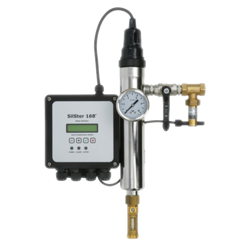Fresh water system bacterial growth prevention
Regardless how sterile the fresh water is when it comes from a fresh water maker or when it is taken in port, there will always be small deposits of bacteria somewhere in the system regardless of how well it has been cleaned. And bacterial growth will occur, especially is the temperature is favourable for it. One common way to inhibit bacterial growth is by adding chlorine to the water. However, in addition to the difficulty of dosing the chlorine correctly and safely, chlorination causes corrosion in the piping, the water will taste and smell of chlorine, and the effect is not very long lasting since the chlorine tends to evaporate from the water. A good alternative is to add silver ions to the water.
A correct and accurate dosing is easy to arrange with a silver electrode in the water since the amount of silver added to the water corresponds directly to the electrical current lead to the electrode. Silver ions do not cause any corrosion or any smell or taste to the water, and their inhibiting effect is much longer lasting than with chlorination. The UK Maritime and Coastguard Agency recommends in its Merchant Shipping Notice MSN1845(M) that a minimum of 0,1ppm of silver ions is added to the water in the FW holding tank to ensure that the silver ion concentration stays at 0,08ppm in the whole FW system.
Concentration of silver ions
For fresh water disinfection it is recommended to add 0.1ppm of silver ions into the fresh water holding tank. The minimum time required for sterilization to take effect is 4 hours after the silver has been added to the water in the tank. This should ensure a maximum of 0.08ppm silver in the distribution system (refering to below).
MSN1845 (M), "Maritime Labour Convention, 2006: Food and Catering: Provision of Food and Fresh Water", Maritime and Coastguard Agency (MCA), United Kingdom.









